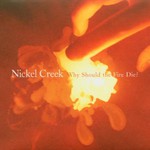Why Should the Fire Die?
Studio Album by Nickel Creek released in 2005Why Should the Fire Die? review
Why Should the Fire Die? is Nickel Creek's first album without Alison Krauss in the producer's chair, and on it, the trio's genre-expanding acoustic music has shifted even farther away from its bluegrass origins. Young band is now under the guidance of Good Charlotte and Queens Of The Stone Age producer Eric Valentine. This is a leaner, even meaner Nickel Creek. The songs are darker, the arrangements thoughtful and full of sharp turns and dark corners. Armed with a bluegrass arsenal (mandolin, fiddle, acoustic guitar) Nickel Creek finds ways to use that genre without being used by it. Bluegrass' harmonies, its silences, its compact parts are all here, but its rigid song structures are not. Nickel Creek steers itself towards a 21st-century mutation of the form with progressive rock undertones.
The opening When in Rome perfectly encapsulates the aggressive approach the band favors, and features poetic lyrics far more obtuse than those of most groups with similar roots. The disc's first half stays rooted in a fairly conventional folk mode, with a lovely cover of Bob Dylan's Tomorrow Is a Long Time (one of the few solo vocal turns from fiddler Sara Watkins) and Jealous of the Moon (co-written with the Jayhawks' Gary Louris) obvious highlights. But the album gradually grows darker. The songs take unexpected twists that are challenging and unconventional, while still emphasizing those angelic vocal harmonies that float and sting. There is no shortage of interesting instrumentals: Scotch & Chocolate, Stumptown, First and Last Waltz all fit in nicely with the album's other songs. Chris Thile's peppy instrumental Stumptown leads into the menacing Best of Luck, with its edgy minor-key chorus echoed by Sara Watkins's deceptively sweet voice spitting out lyrics of an obsessive high-school love affair gone wrong. And the drums of Helena, one of the group's most radical compositions, bring out Nickel Creek's inner Coldplay.
Why Should the Fire Die? makes a bold departure from previous efforts. Maybe it is the new producers or maybe it is just the band's increased freedom as a result of self-sustaining sales. In either case, the album is just about as diverse as they come. Nickel Creek finally shed their youthful innocence, delivering a complex and decidedly adult collection of progressive bluegrass and folk. If the thought of sweet Nickel Creek in such mean-spirited mode makes you uneasy, picture the song's ire aimed at the assumptions and limitations placed on this band that formerly sang sweetly about foxes and lighthouses. There's more life here: sickness, sadness and busted romance. A thoroughly pleasing disc Why Should the Fire Die? captures Nickel Creek at a time of growth, their mesmerizing harmonies and prodigious playing now fueling some great music.

